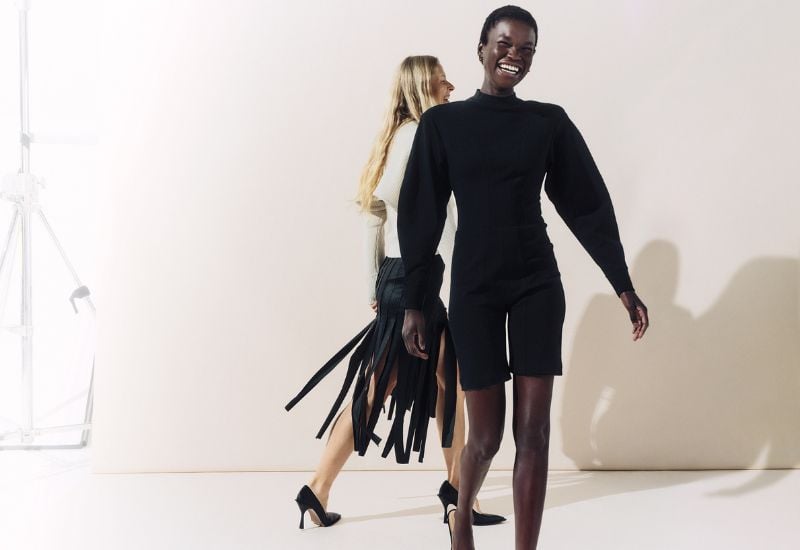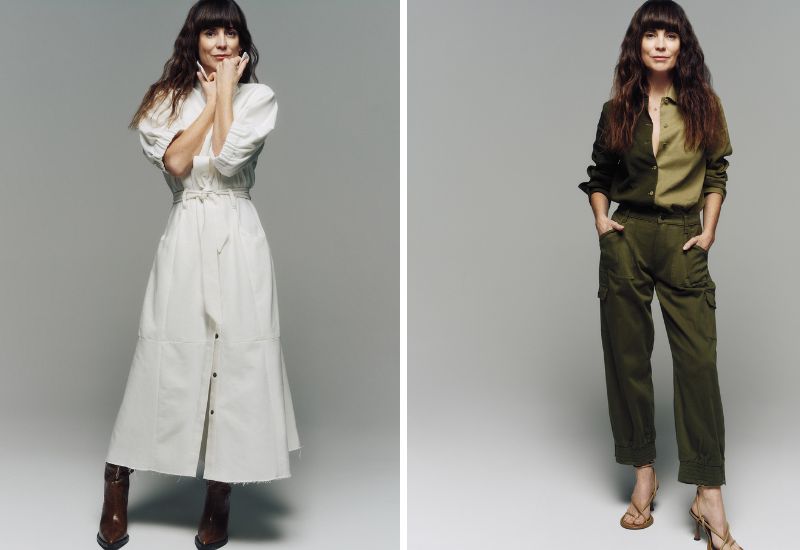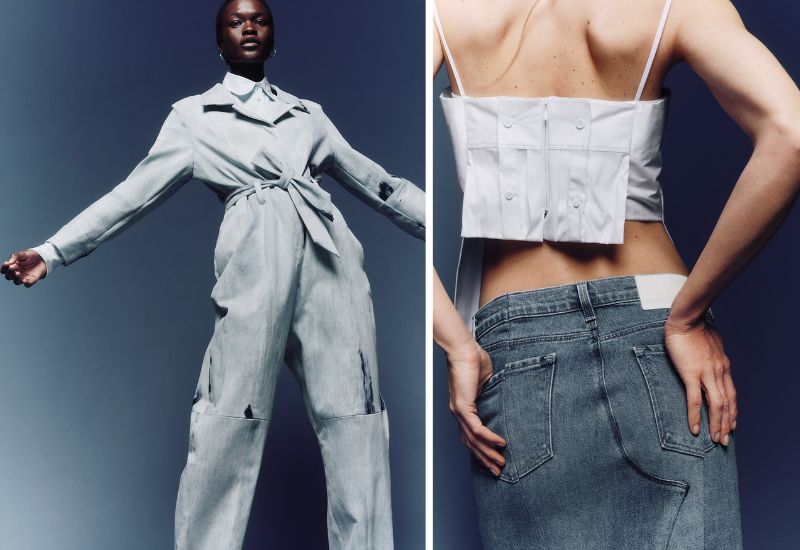In an interesting collaboration, luxury online retailer, THE OUTNET, introduces a limited edition capsule collection by E.L.V. DENIM.
Comprising 50 unique pieces, this exclusive range marks a milestone for THE OUTNET, as it embraces sustainability through the art of upcycling.
Designed by the visionary Anna Foster, E.L.V. DENIM, which stands for East London Vintage Denim, epitomises a commitment to creativity, style, and environmental consciousness.
E.L.V. DENIM challenges norms by transforming past season leftover deadstock into bespoke fashion, all meticulously produced in the heart of East London.
In a freewheeling chat with Emirates Woman, Anna speaks about this collaboration at large and the journey behind building this brand.

What inspired you to transition from a successful career as a fashion editor to founding E.L.V. DENIM with a focus on sustainability?
I had become somewhat despondent with how I felt the industry was ‘behaving’ and I knew that there had to be different way forward. I wanted to create a brand that had sustainability at the heart, and that this ethos governed every decision.
I, myself, recognised the strong emotional connection towards the one-of-a-kind pieces that I was lucky enough to be gifted or find in sample sales. I didn’t see why that had to be an exclusive feeling to those in the industry and I wanted to share this with everyone. By upcycling vintage denim, it means that every single jean is one of a kind. Everyone who owns a pair will have their own unique piece and therefore will be inspired to look after it to last a lifetime. It just changes consumer’s perception of owning and being responsible for a garment.
I chose denim as my starting point, as I absolutely love this material, that was designed to be a hard-working fabric. Unfortunately, denim is also one of the most polluting materials when it comes to its creation, and there are more jeans than people in the world, so I felt it was so important to start to ‘make good’ all the damage to the environment with the creation of the material in the first place.
It was a clear-cut decision to produce only in London, it naturally means we have the lowest carbon footprint, and I am able to work really closely with all my ateliers. I believe as a London based brand, I have a duty to support the local community and businesses. East London has a strong history of fashion manufacturing and I want to play my part to make sure it keeps growing.

In challenging the status quo of the denim industry, what obstacles did you face, and how did you overcome them to establish E.L.V. DENIM as a sustainable brand?
Like many, I found shopping for jeans really difficult. As a consumer I felt frustrated that I didn’t conform to how a denim brand wanted me to be. With E.L.V. DENIM I wanted to completely turn this around and let our products conform to how a woman or man wants be. We are known for our contrast colourways that are created with a seam running up the front and back of each leg. This is not only an aesthetic design, but a functional one as we have a generous seam allowance. The seam allows us to create the perfect fit but, and this is unique to us, it also means that they can be altered. We all change as we go through life, and these seams allow the jean to adapt as the consumer evolves. You can buy our jeans at 18 and still wear them at 80. I believe we have a jean for ‘every body’ and in doing so we create handcrafted luxury items that last a lifetime and that is certainly something to be celebrated.
We only put rigid denim into our jeans, as stretch jeans inevitably stretch out of shape and the consumer throws them away and buys a new pair. Rigid is the only denim that will last forever. However, stretch denim is increasing in quantity in the vintage market, and therefore we have a duty to try and rework this. We won’t put it into our jeans, but we extract the material and rework it into our tailoring such as our skirts and jumpsuits. If you constrain stretch material by sewing seams around all the sides, it can’t move anywhere. This was an unavoidable obstacle, but with thought and process we were able to turn it into a beautiful solution.
The exclusive capsule collection with THE OUTNET is a significant collaboration. How did this partnership come about, and what unique elements does this collection bring to the fashion market?
We had been talking to THE OUTNET for a long time, but although we couldn’t work together in their traditional way, we were both keen to find a new way forward as we share the same ethos to revalue garments that already exist. So, I proposed the question to upcycle pieces from past seasons from the brands that are held on the OUTNET and here we are now!
This collaboration is the first of its kind with a global retailer, and most importantly presents upcycling as a viable business, and revenue driving, model.

E.L.V. DENIM’s three guiding principles are Handcrafted, Upcycling, and Luxury. How do these principles shape the brand’s identity, and why are they essential to your approach in sustainable fashion?
Firstly, we celebrate material that already exists in garments. We are the only denim brand in the world never to cut from a roll of fabric or use virgin fibres and I am very proud of that. Our hand curating sourcing ensures that quality of fabric is our priority. We grade each garment and each of the 8 measurements indicates what it can become. Once a jean is graded, we consider, and reconsider each garment, before deconstruction. This process is really important as our goal is to extract as much material as possible, as our design reconstruction respects the properties of the material and original characteristics of the garment. It takes time, but this is where the quality in the final garment comes from.
Our pieces are manufactured one at a time, the atelier addressing the garment as if approaching it for the first time, by hand cutting and reconstructing with care. We champion slow manufacturing as that is the only way we can guarantee quality.
The capsule collection includes a range of items beyond denim, such as leather, knitwear, and tailoring. How do you ensure that the same sustainable practices are maintained across different materials?
The process is exactly same for E.L.V. DENIM. Governed by what is available we constantly innovate from what is in front of us. Our practices remain the same to guarantee the high quality that we are known for.
Can you share more about the creative process behind designing hero pieces?
Quite often the design and the material doesn’t work perfectly, I love to take that material and rework it into a design that respects it. It’s hard to explain but I can see exactly what they should become as I look at it. The transformation process is the best part, it’s fun, it inspires me as we are ensuring that this material can live on forever in the garment it finally becomes.
In the case of the leather-fringed gladiator, it was made from 4 pairs of stretch leather leggings. We used the existing form of the waistband and used techniques to deconstruct the rest of the garment and rework it, incorporating the existing characteristics of the material.
The Chunky Cashmere twinset was created out of a ‘regular’ style sweater. By creating two items out of it we give the consumer the options on how to wear it, whether together or separate. I love the idea of giving someone two items instead of one.
This modular concept is something that runs through the collection, a leather dress can be zipped apart worn as a skirt & a top; a jacket can be worn long or worn short. It just adds conceptual value to the piece, a quality you want to celebrate.

How does this technology enhance the customer’s experience and contribute to the brand’s transparency?
Each individual garment from the capsule has a Digital ID embedded, with a scannable QR code that gives customers greater post-purchase information. This can include product provenance, styling, and care guidance, as an easy way for our customers to check back in for useful tips, and help keep each piece in use for as long as possible. We see exciting long-term potential for Digital IDs, which can be considered the garment’s own product passport. They can be a positive tool to improving each customers’ experience – and connection to their products – as well as product traceability, authentication, and lifetime value. – Emma Mortimer, Managing Director, THE OUTNET.
E.L.V. DENIM’s commitment to minimal waste is evident, even in the swing tags made from excess material. How does this approach align with the brand’s overall mission and sustainability goals?
Constantly innovating, trying to be better every time. Every collection we look for additional ways to innovate using pieces that would be considered waste 99% of the time. Our goal is to use every piece of material in our possession into something meaningful. Slow and considered manufacturing is the only way we can protect our future generations.
As a pioneer in circular fashion, how do you envision the future of upcycling on a larger scale for ready-to-wear collections?
When I started E.L.V. DENIM, countless amounts of people told me it wouldn’t be possible to build a successful upcycling business model, look at where the brand is now. So now I want this collaboration to be the blueprint of the future for fashion. Where all luxury brands and retailers can see upcycling of end of season garments as exclusive collections running alongside their RTW collections. I have a vision, and I truly believe in it.
– For more on luxury lifestyle, news, fashion and beauty follow Emirates Woman on Facebook and Instagram
Images: Supplied












